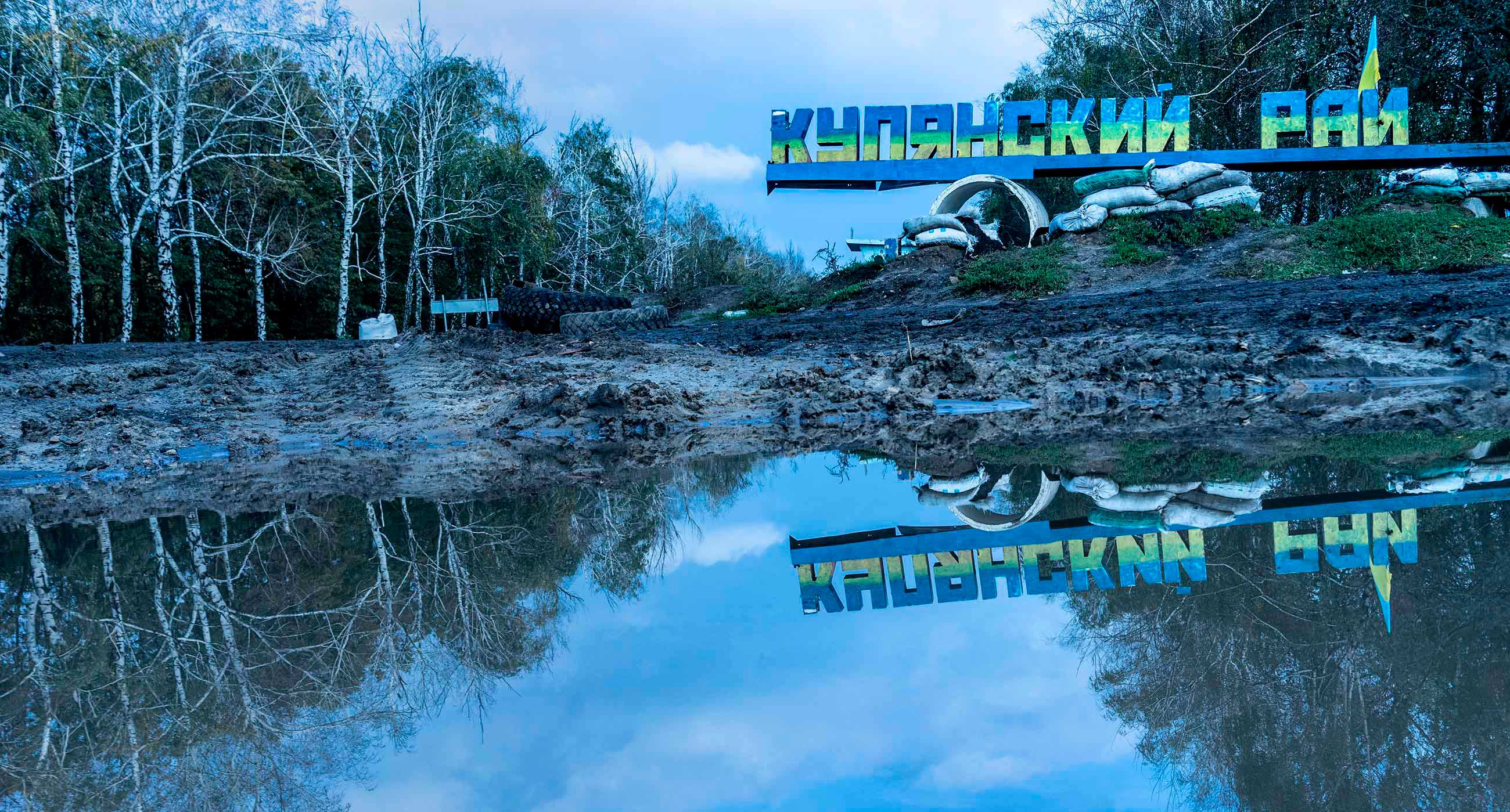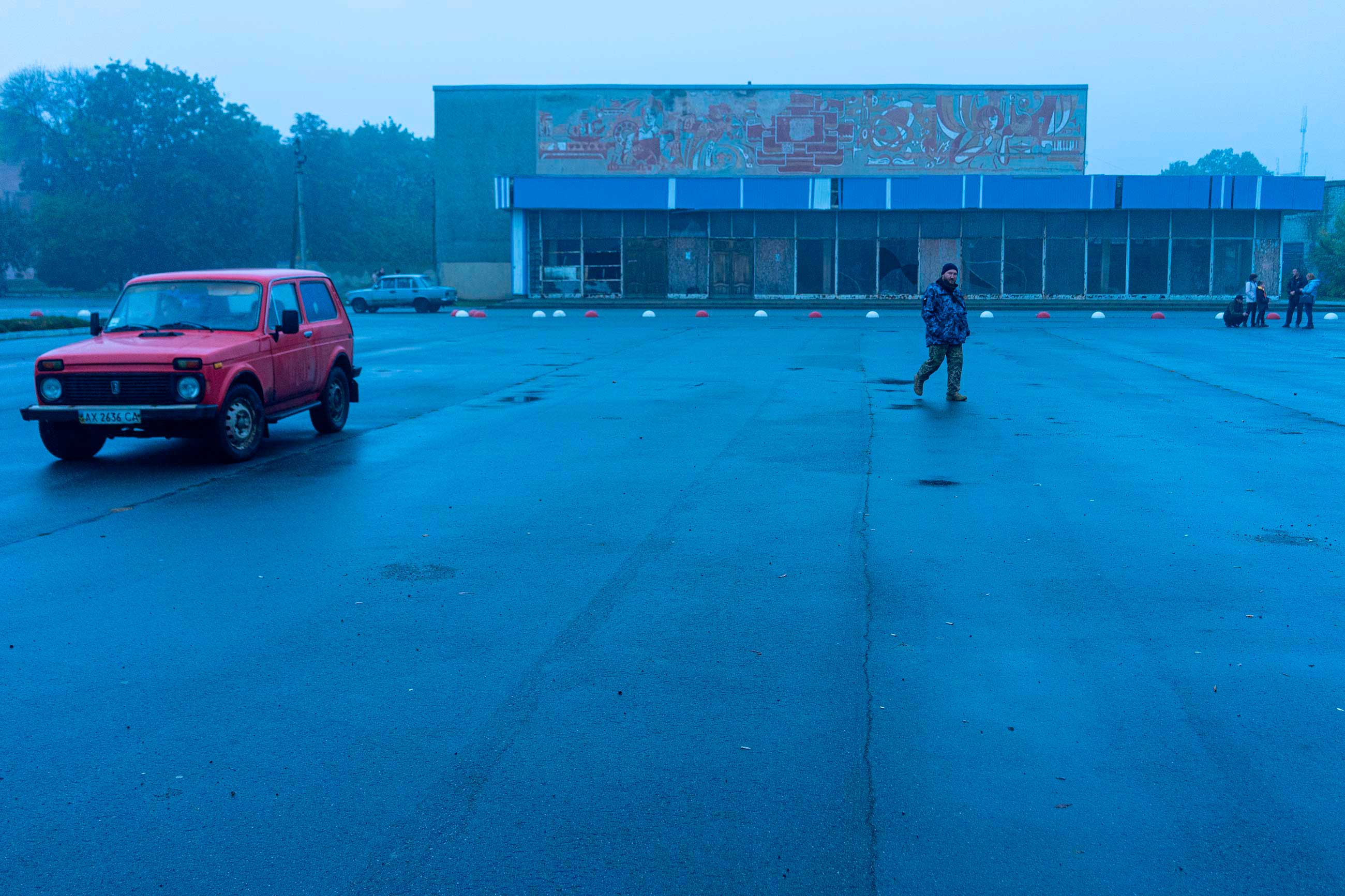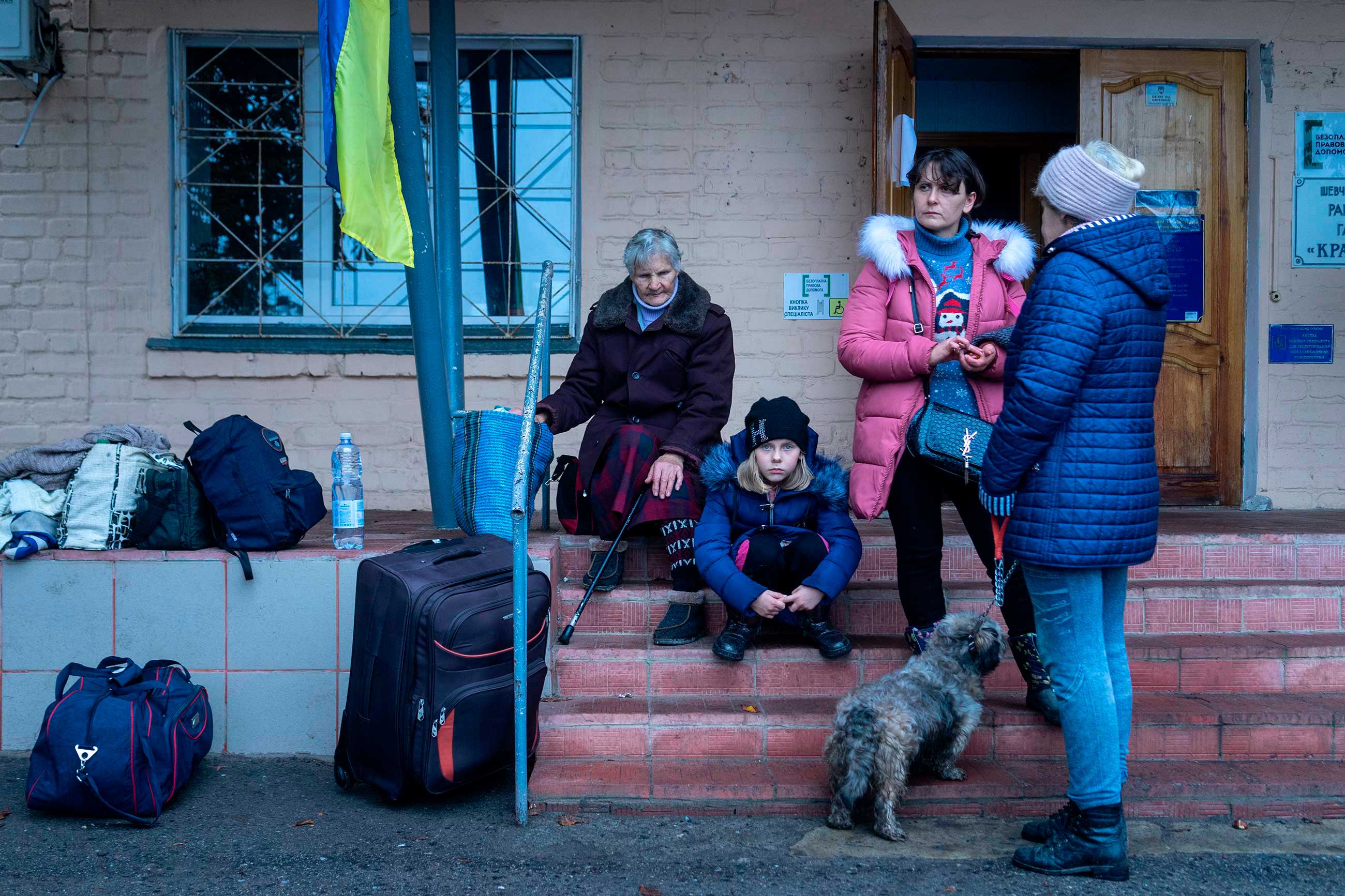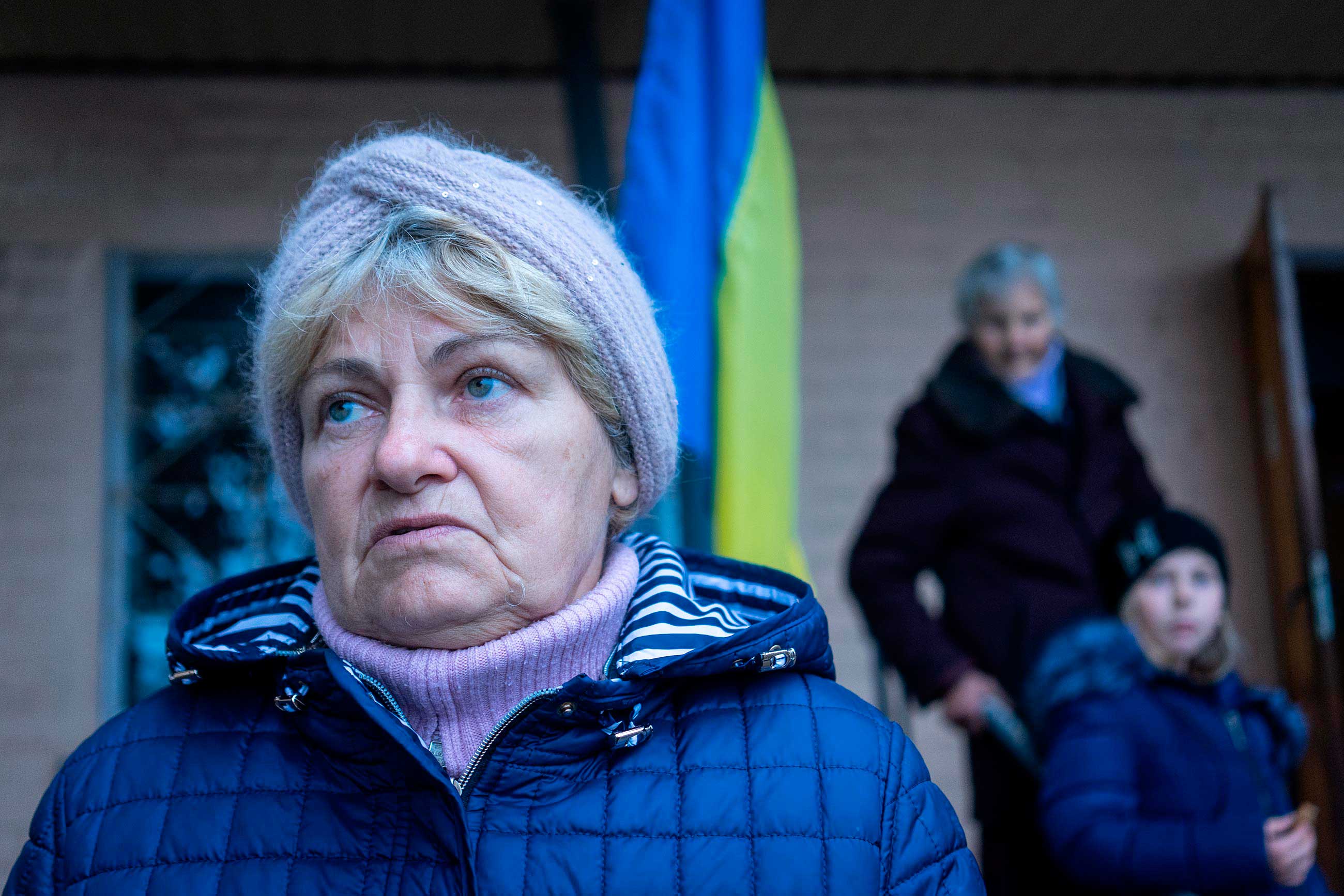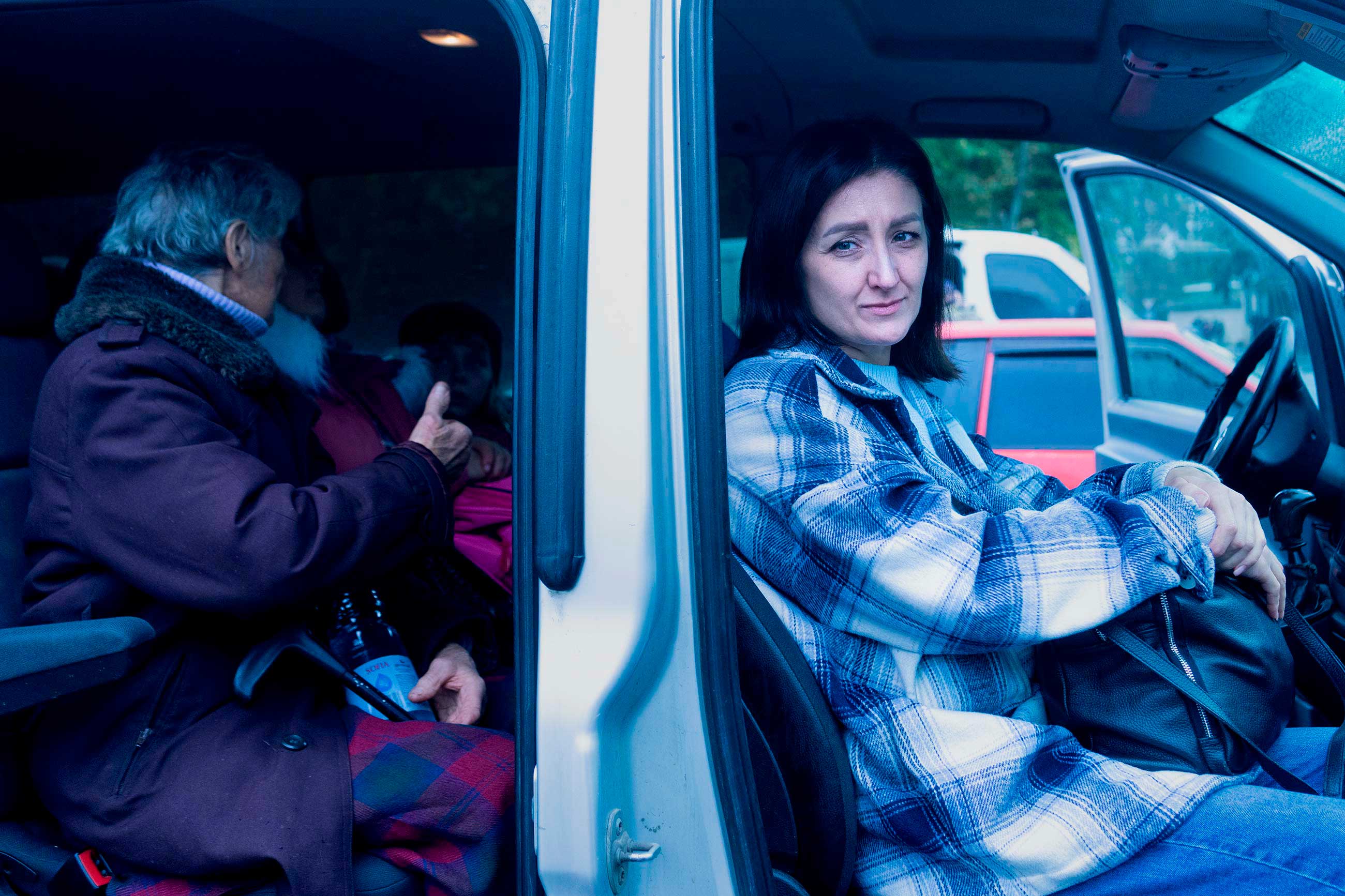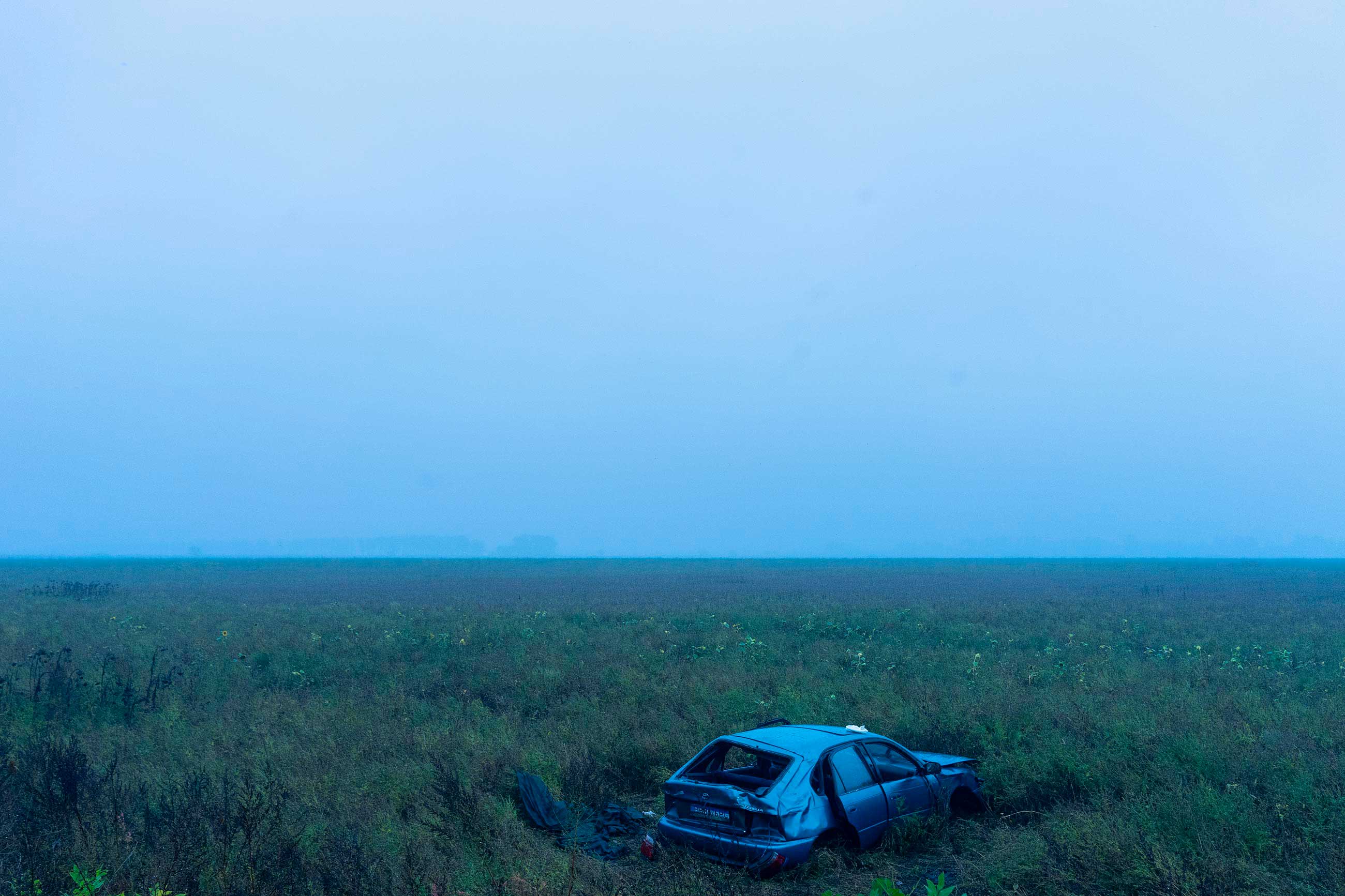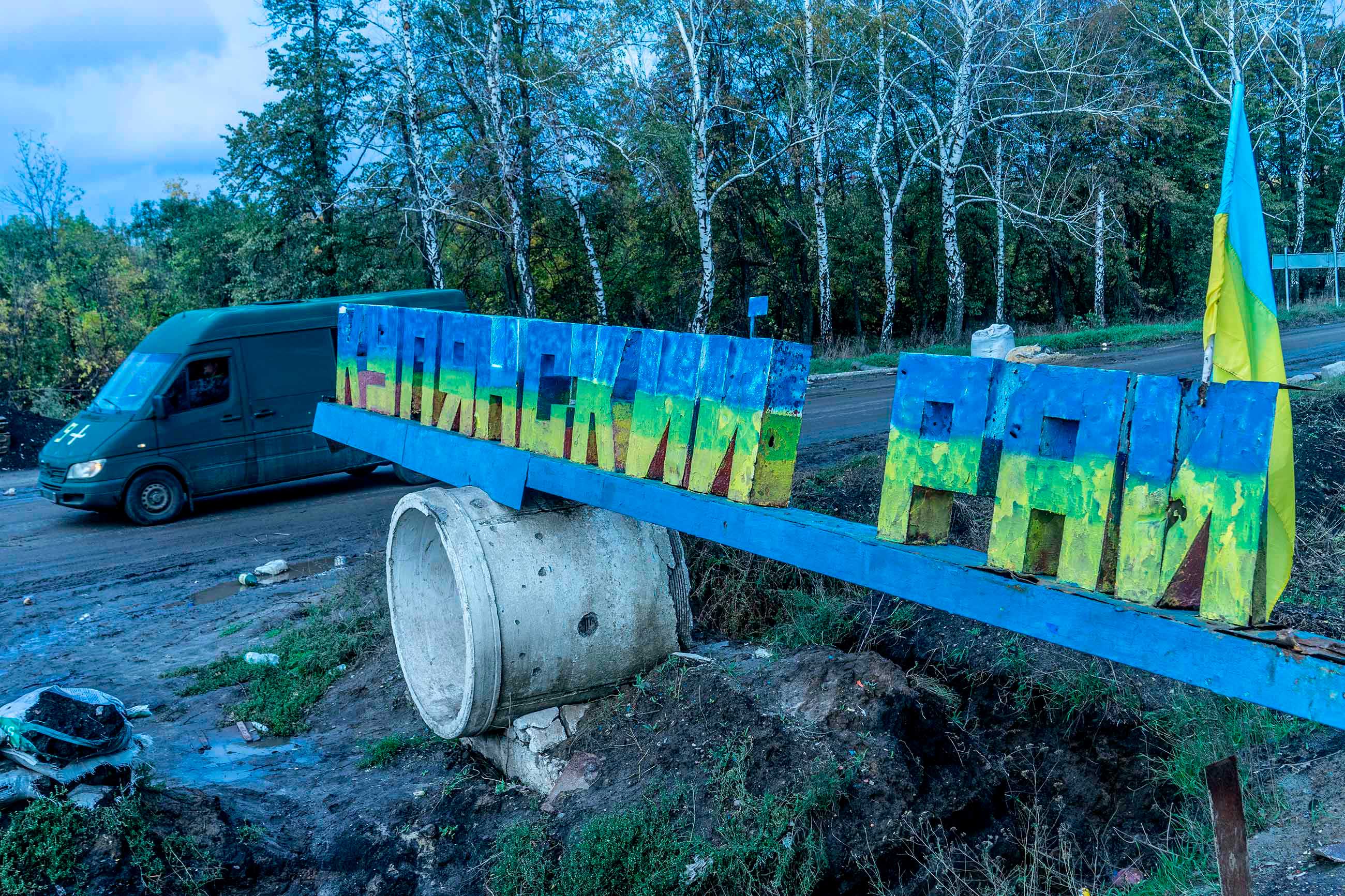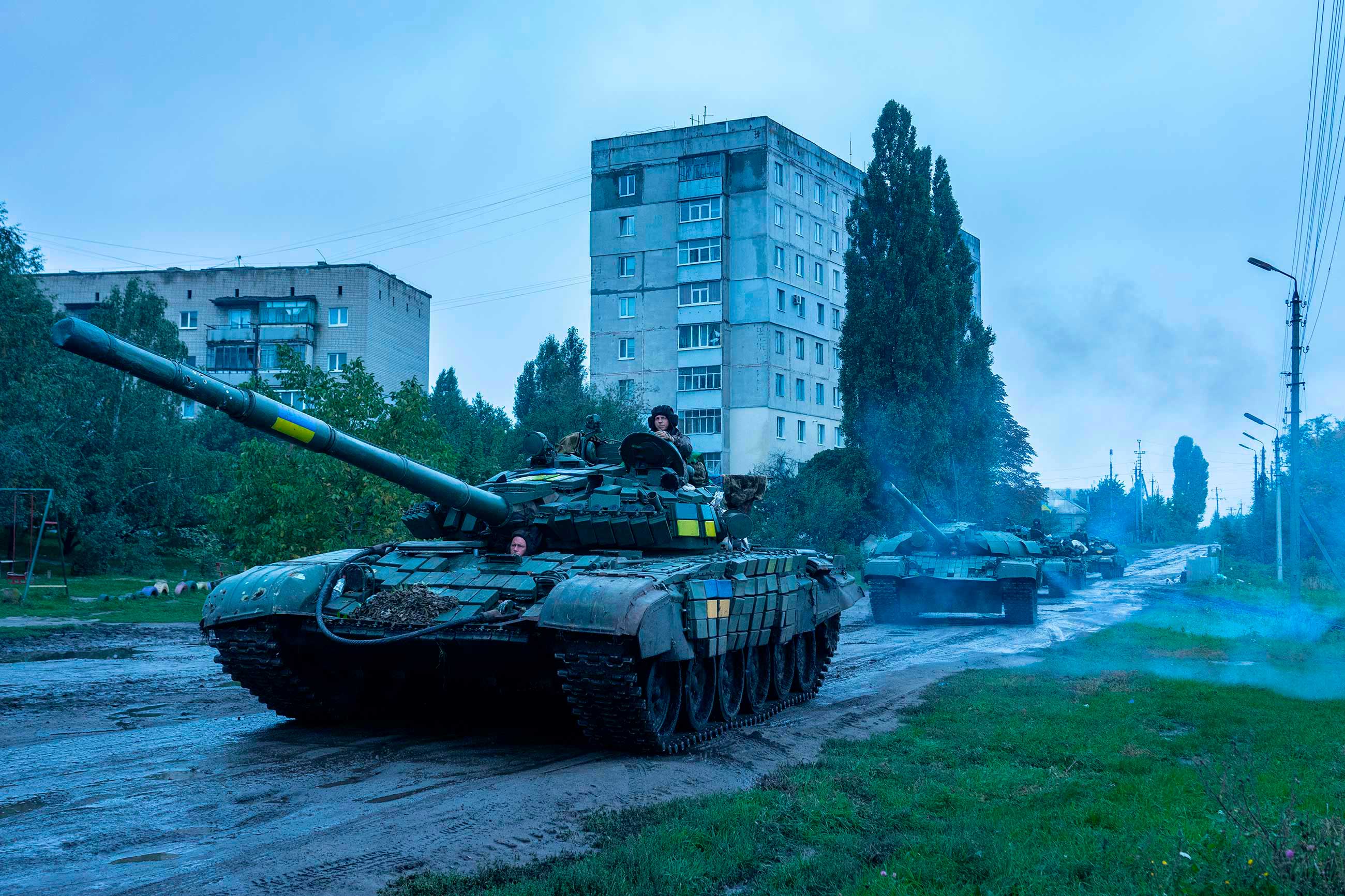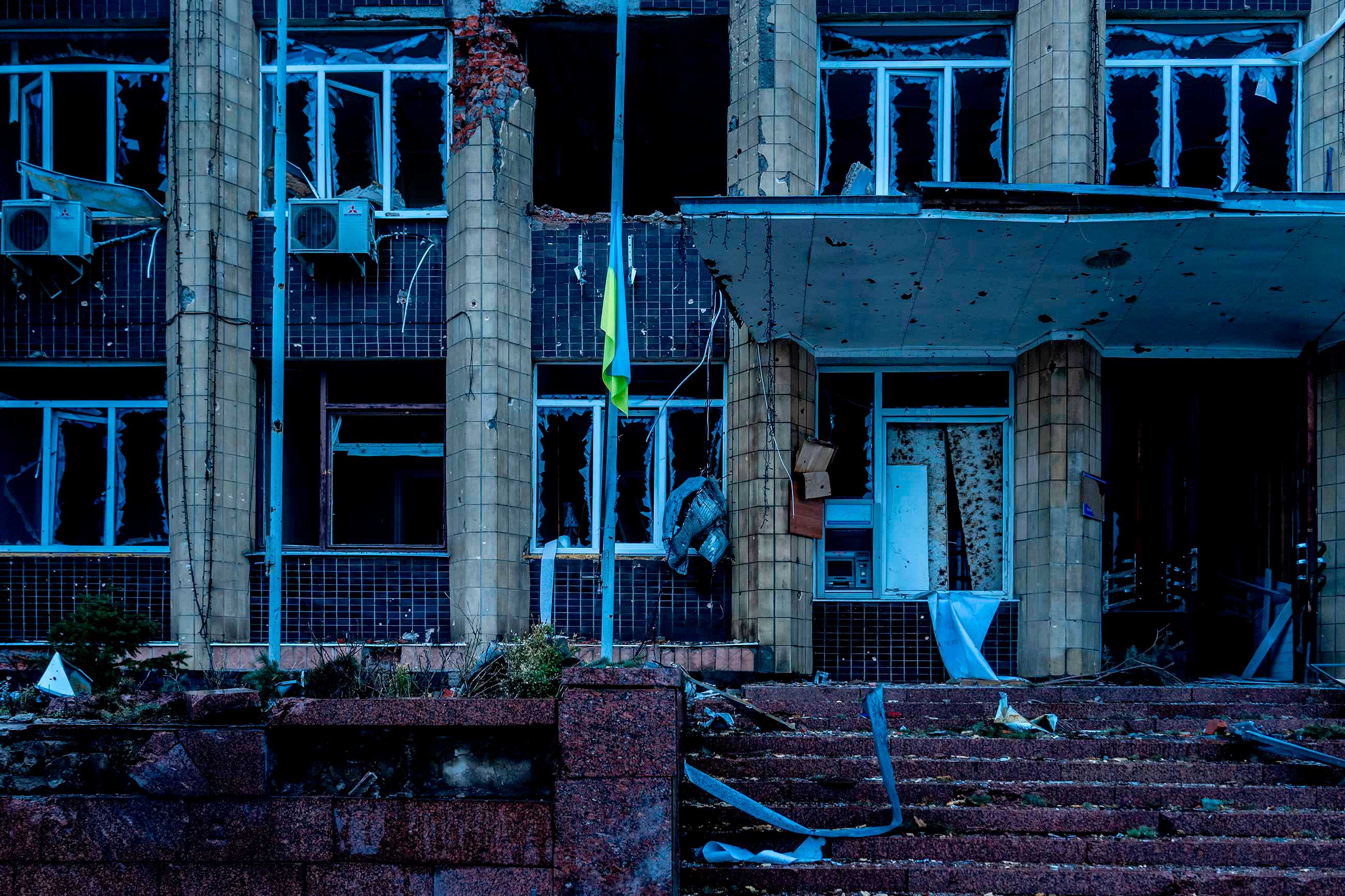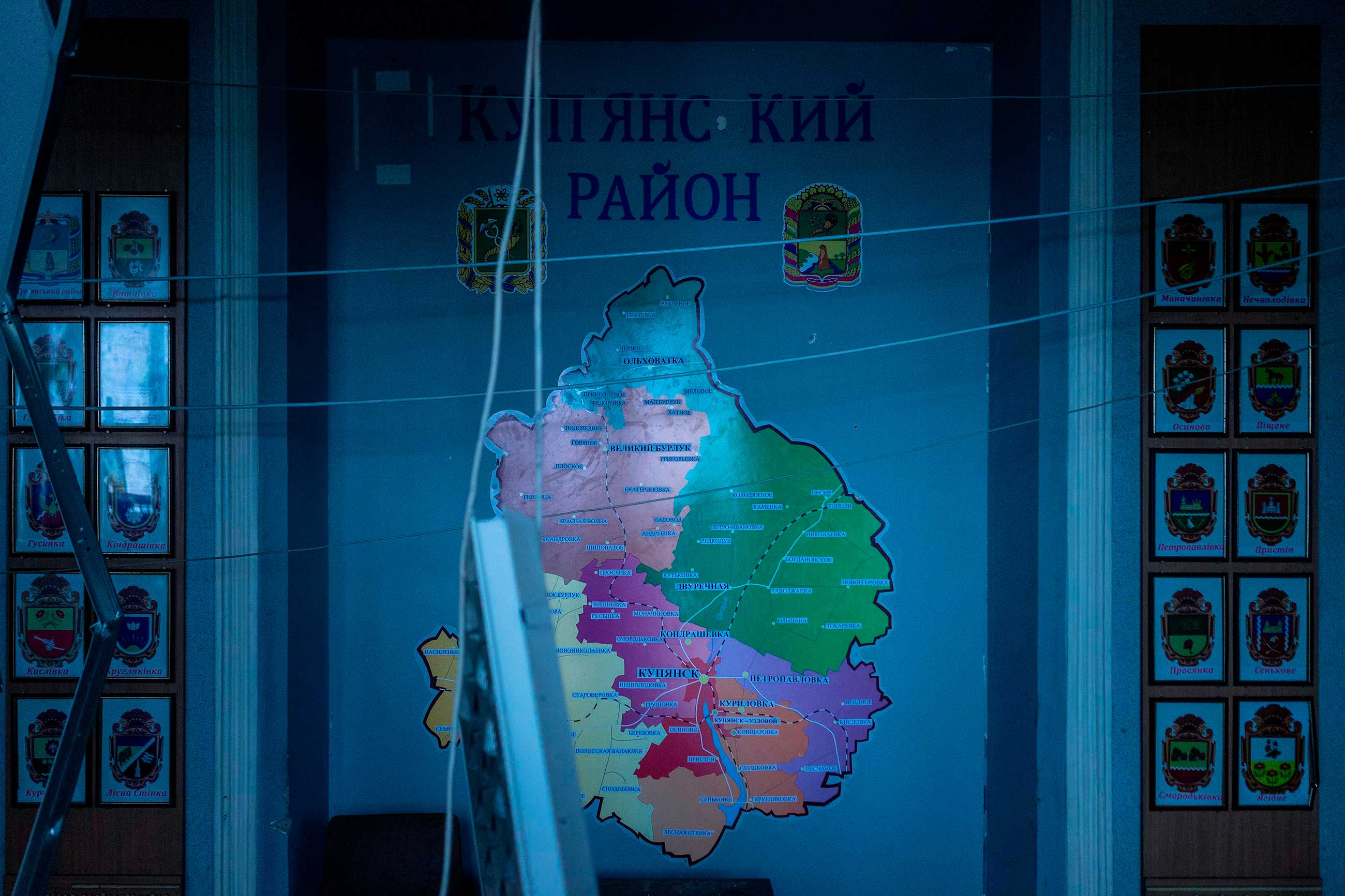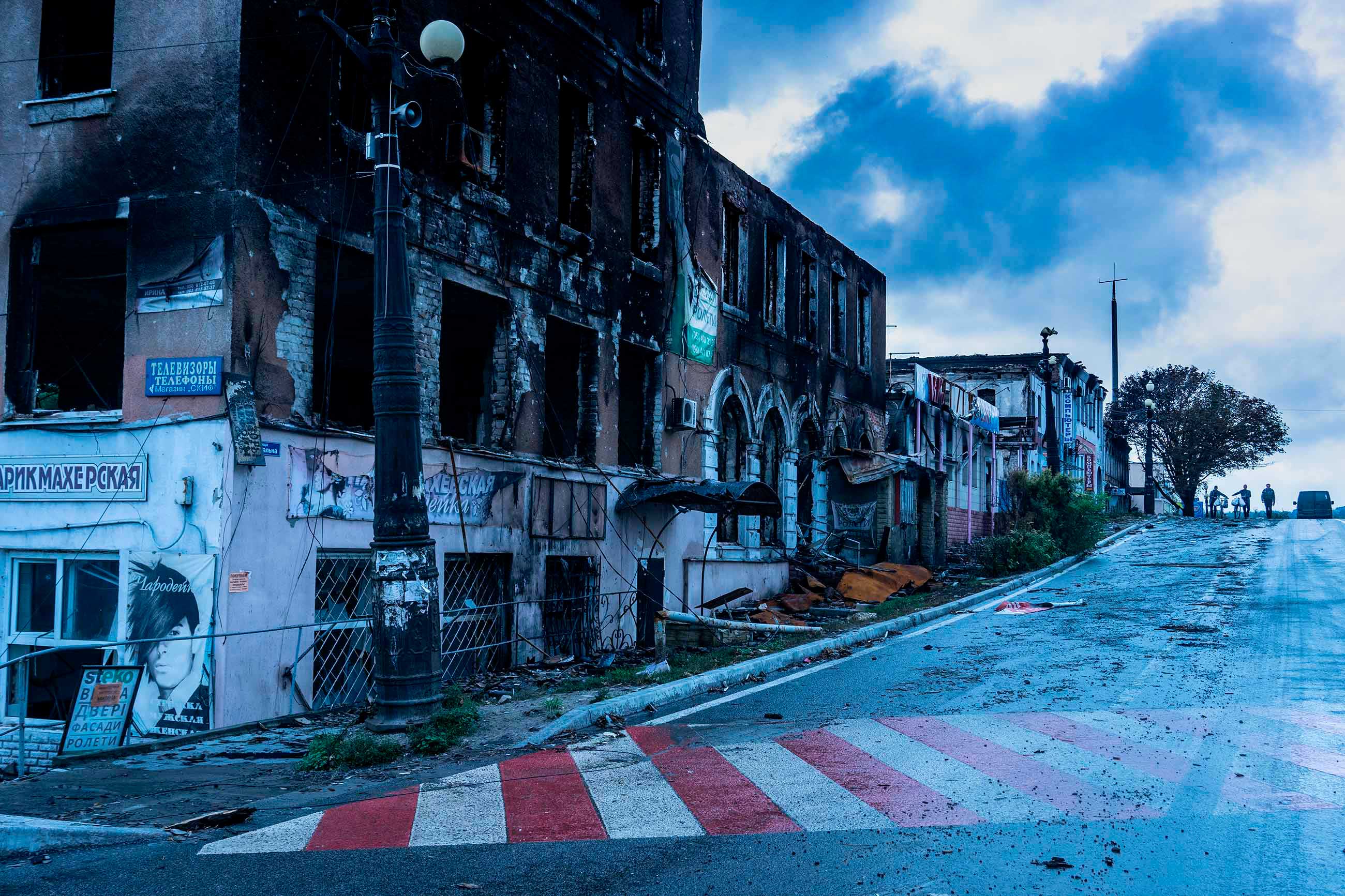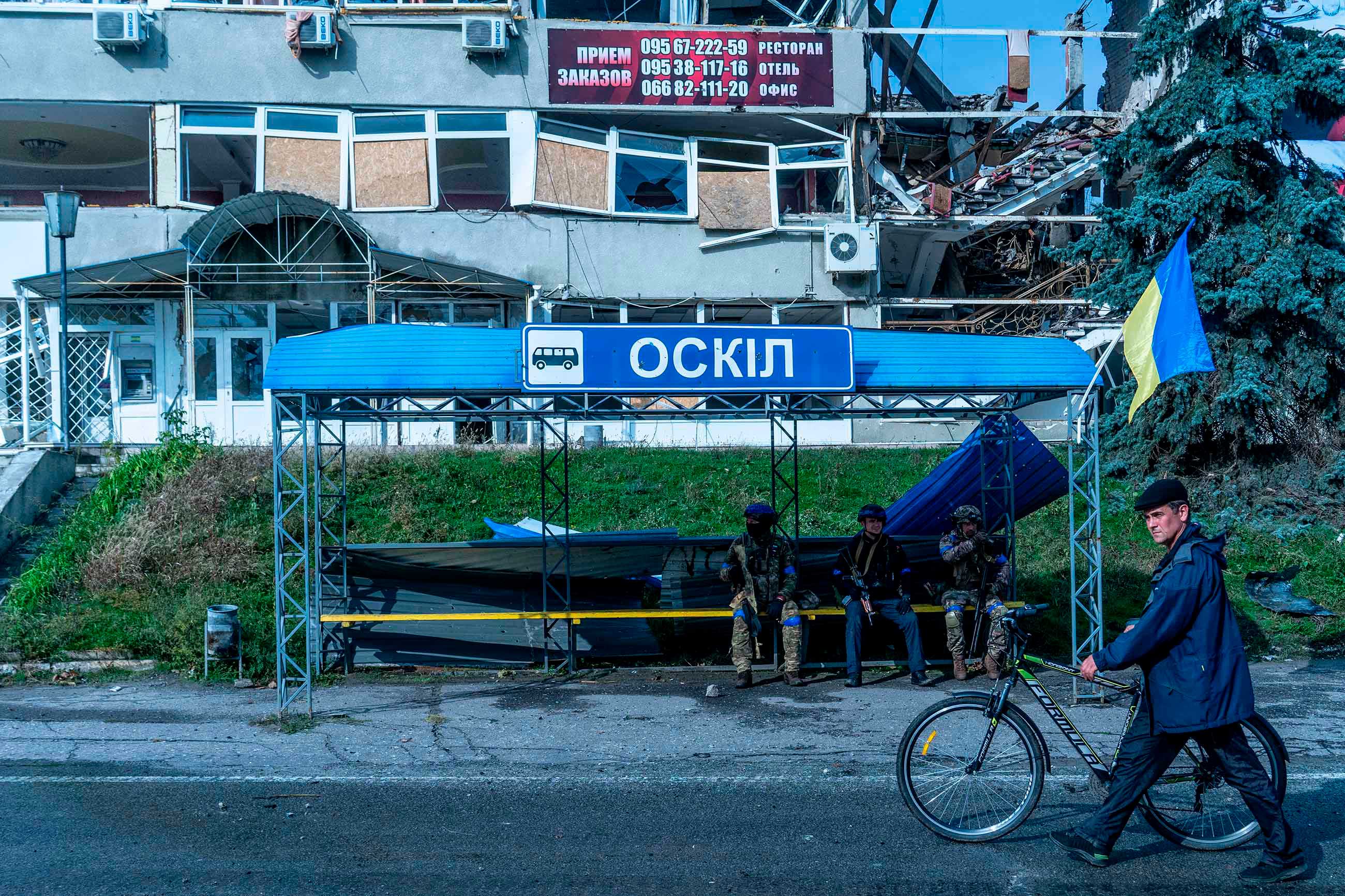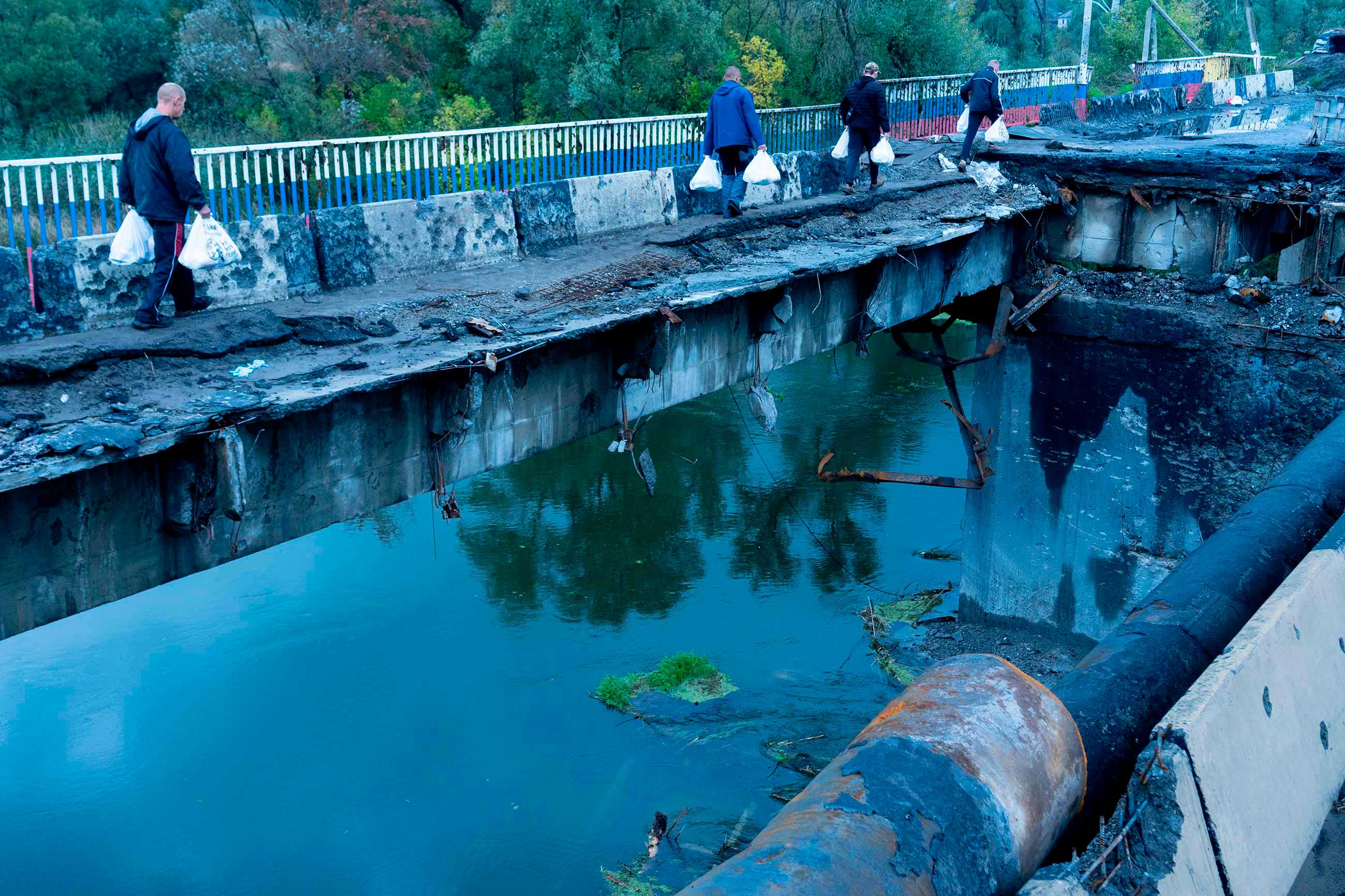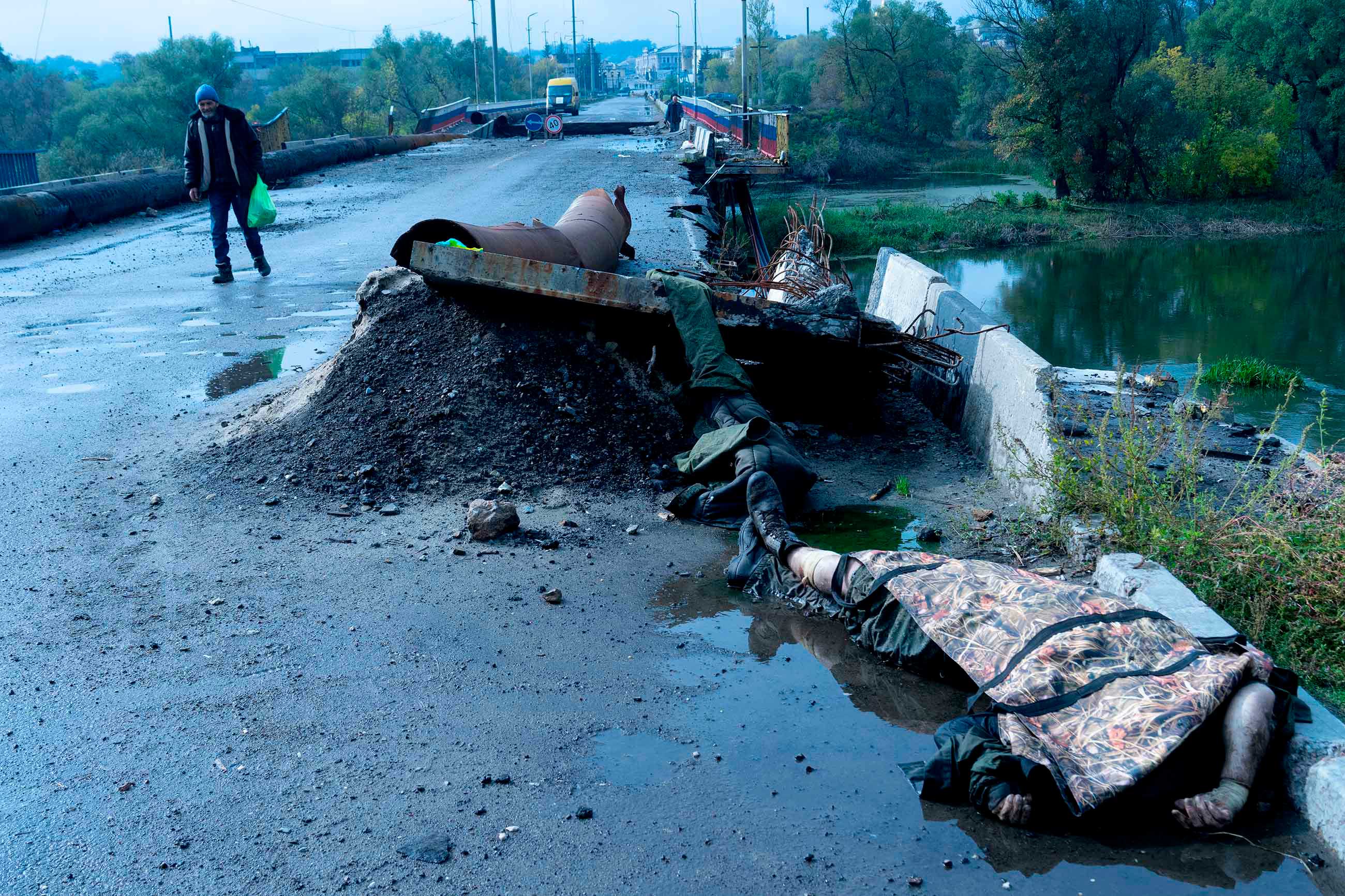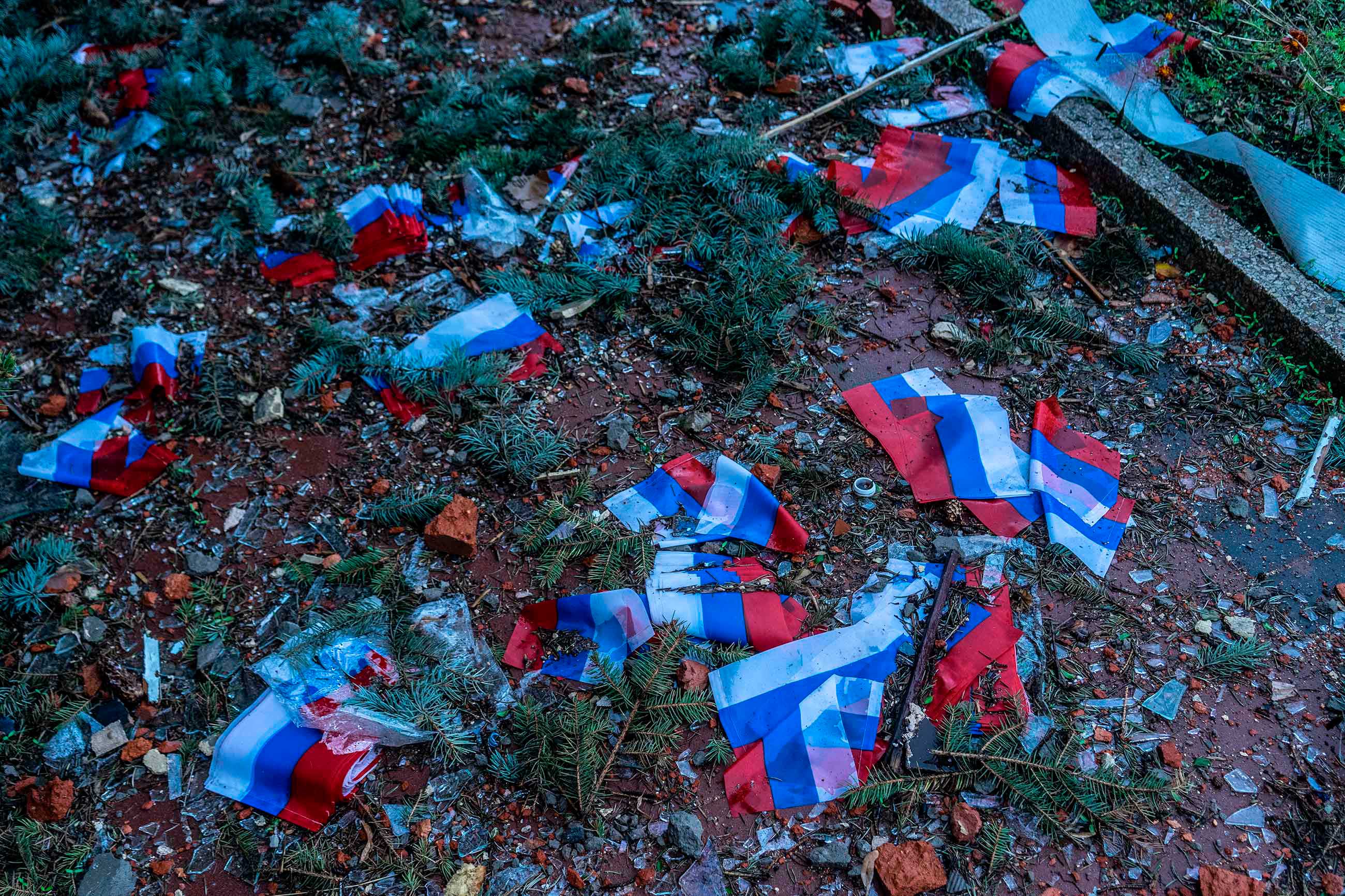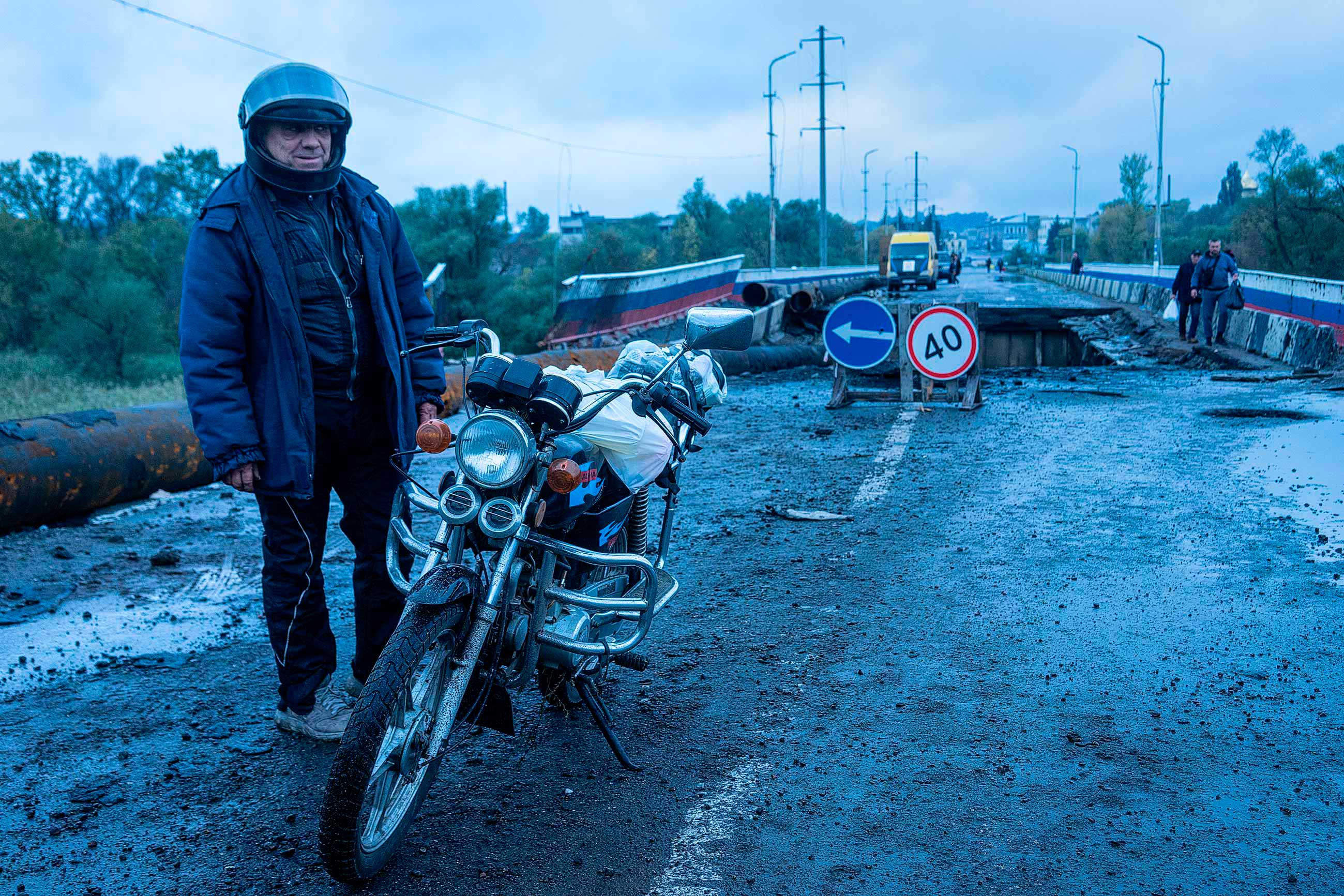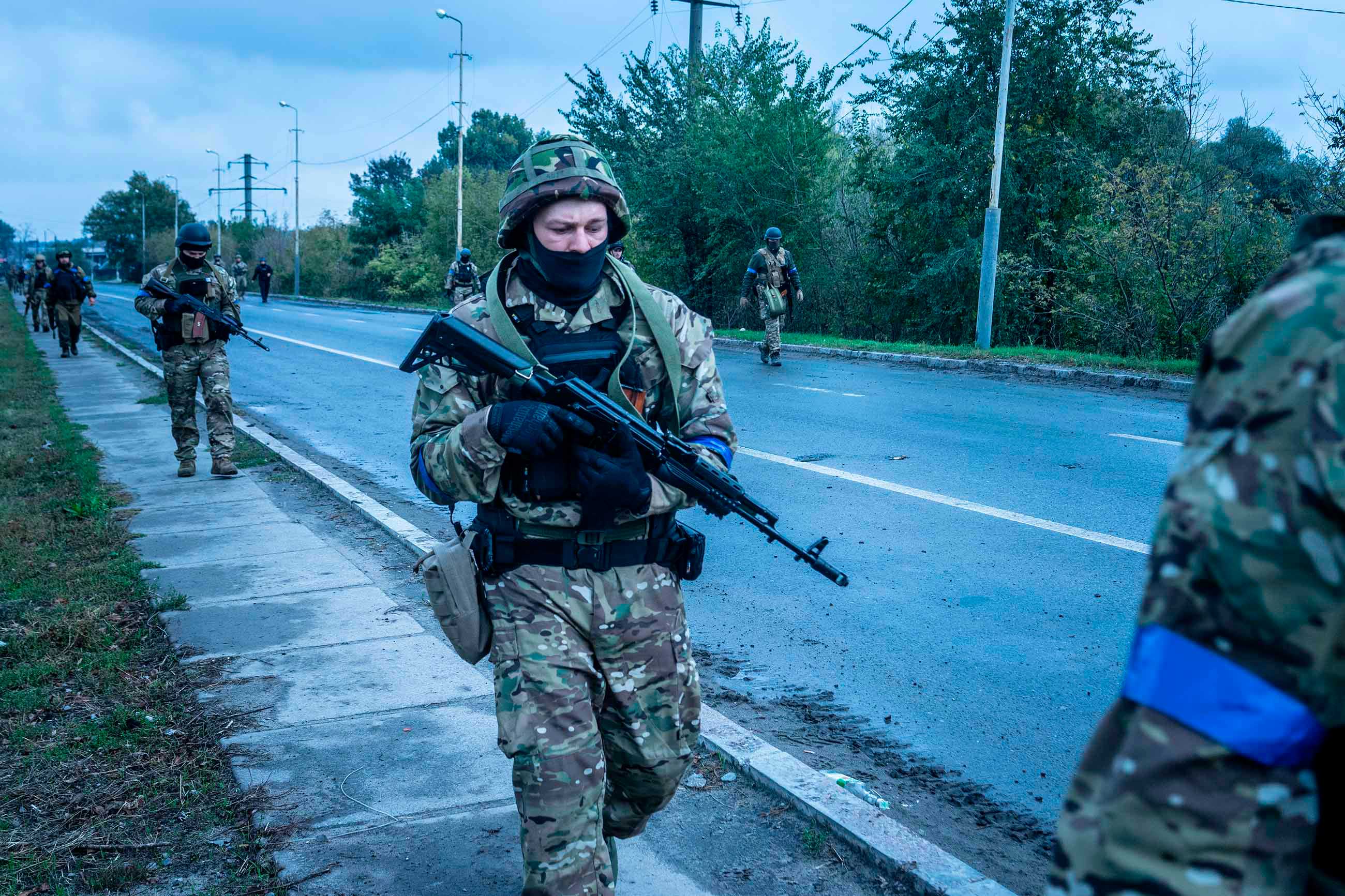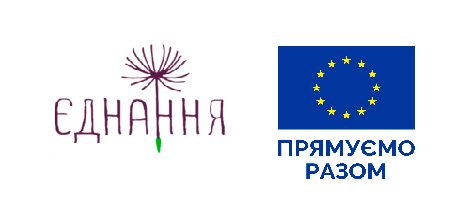Kupyansk is a city in Kharkiv Oblast, located on the border with Luhansk Oblast. Before the full-scale invasion, about thirty thousand residents lived there. The town was occupied almost immediately, on February 27, Russian troops were already there. They occupied all administrative buildings, painted the fences with the tricolor, and set up a torture chamber in the local police station for those who disagreed with Putin’s regime. In September, the Armed Forces of Ukraine entered Kupyansk. The mass media often write that the city has already been deoccupied, but battles are still on its outskirts. Zaborona journalist Polina Vernyhor and photographer Ivan Chernichkin visited Kupyansk, came under fire, visited the place where humanitarian aid was distributed, and showed what the occupiers had turned the city into.
Shevchenkove
The road from Kharkiv to Kupyansk passes through the Shevchenkove village, which was occupied for more than half a year. On September 7, Ukrainian troops drove the Russians out of there. Shevchenkove is now the first point on the way to evacuate Kupyansk and nearby villages. Dozens of refugees come here every day. Some stay in Shevchenkove, hoping to return home, but the majority goes further to Kharkiv or other big cities.
-

Square in the Shevchenkove village. Photo: Ivan Chernichkin / Zaborona
We arrived in Shevchenkove around 9 in the morning. At such a time, many people gathered on Central Square near the local administration — locals who came to receive humanitarian aid and those who had just left Kupyansk under shelling.
-

Refugees in the Shevchenkove village. Photo: Ivan Chernichkin / Zaborona
Among the people on the square, we meet a woman who introduces herself as Lyubava Podolyanochka — this is the nickname people call her in her native village of Podoly, located in the suburb of Kupyansk. It was released from the occupiers a few days ago. However, due to the fighting in Podoly, as well as in Kupyansk itself, electricity, gas, and water supply disappeared. The village continues to be shelled — Russian positions are a few kilometers away. Therefore, the woman decided to leave the village with her cancer-stricken husband.
-

Lyubava Podolyanochka. Photo: Ivan Chernichkin / Zaborona
“My head doesn’t work after these explosions, and it’s as if I went nuts. At the beginning of the war, we sent our daughter and granddaughter to the controlled territory [of Ukraine]. We wanted to leave, but we stayed. People make a living, and you don’t want to leave it. Then we couldn’t leave,” says Lyubava.
Lyubava’s house survived. Neighbors had windows blown out, roofs destroyed, and walls burned. The woman says that in her village, many people were injured and died. Due to constant shelling, her husband’s heart started to hurt more often. However, there is not a single hospital or medical center in Podoly and in Kupyansk itself.
“For half a year, we hardly left our yard. Many pro-Russian people were in the village, so we tried to communicate less because anyone could betray us. Perhaps a few such pro-Russian peasants remained, but most left for Russia. Someone left immediately after the occupation and left with the Russians on tanks,” says Podolyanochka.
Not far from Lyubava, Iryna is waiting for evacuation. The woman left Kupyansk. When we ask her about her hometown, tears appear in her eyes. Irina was lucky — she still had a job. The woman worked as a baker, so she baked bread for civilians in a local bakery almost daily. Her husband, father-in-law, and mother-in-law lost their jobs.
-

Iryna from Kupyansk during evacuation in the Shevchenkove village. Photo: Ivan Chernichkin / Zaborona
“The products were all very expensive, and everything was brought from Russia. Some food was humanitarian aid. I didn’t get it because I could afford to buy it. They tried to supplant the hryvnia, and the last exchange rate was 1 ruble for 1.25 hryvnias. A pork rib cost about 185 hryvnias, and I was even afraid to ask about the meat — I think it was 260 hryvnias. A liter of oil was for 100 hryvnias,” says Iryna.
In Kupyansk, says Iryna, the occupiers issued Russian passports. Local collaborators lined up behind them. However, according to the woman, it was realistic to live in Kupyansk without a Russian passport because there was no work anyway and no administrative services.
The woman heard from acquaintances about the persecution of people for their pro-Ukrainian position — one guy was taken away and beaten badly, and they broke his eight ribs.
“Paradise in Kupyansk”
Colleagues said it was almost impossible to film in Kupyansk: they were forced to lie under the curb because the city is constantly being shelled. However, several interlocutors in Shevchenkove confirmed to Zaborona that Kupyansk was quiet all last night and morning. To enter the city, journalists must get a pass from the military administration located in Shevchenkove. No one asked us for a long time about the purpose of the visit — they only checked the accreditation and entered passport data and car numbers in a paper journal. The same information is duplicated in the pass.
-

On the way to Kupyansk. Photo: Ivan Chernichkin / Zaborona
With the pass ready, we leave Shevchenkove on the road leading to Kupyansk. The route is clean – very few cars, primarily soldiers and volunteers. There are mangled cars, burned-out Russian tanks, and armored personnel carriers on the roadsides. Sometimes — trenches abandoned by the Russians. We pass several roadblocks – passports, passes, and accreditations are checked each. The military are friendly. “Have a good and safe trip,” they say to passers-by.
There is a large pedestal at the entrance to the Kupyan district. To “denazify,” the Russian military removed the Ukrainian soft sign from the name. The last two letters are missing — it reads: “Kupyansk Paradise”( the word “district” translated into Ukrainian and without the last two letters sounds like “paradise” in Ukrainian). Local people have already repainted the pedestal in yellow and blue.
-

Entry to Kupyansk. Photo: Ivan Chernichkin / Zaborona -

Ukrainian tanks enter Kupyansk. Photo: Ivan Chernichkin / Zaborona
At the entrance to Kupyansk itself, we meet a column of Ukrainian tanks. There are almost no people on the streets. There is only a crowd near one of the buildings on the city’s outskirts, where people can get humanitarian aid. At first glance, the town seems intact compared to Izyum. However, the deeper we go into Kupyansk, the more it becomes clear: the city is completely destroyed.
There are almost no buildings in the center that were not affected by shelling. Residential buildings, shops, administration buildings — everything is dilapidated, with broken windows and without any signs of the presence of people. Most of those we meet in the center are military or police — a civilian rides by on a bicycle in the distance.
A pile of walnuts
We drove up to the square near the Kupyansk District Council. At the entrance to this building, Ukrainian military personnel of the 92nd Separate Mechanized Brigade of the Armed Forces of Ukraine took a photo of the raising of the Ukrainian flag on the 10th of March.
The administration building was bombed, and there were no whole windows. Probably, the Russians attacked it already after the deoccupation of the right bank of the city. Abandoned wet documents and personal belongings of the occupiers — from books to clothes — remained intact. As well as the poster “We are with Russia! One people!” hanging from the side of the main entrance.
-

Administration of the Kupyansk District Council, September 28, 2022. Photo: Ivan Chernichkin / Zaborona -

Administration of the Kupyansk District Council, September 28, 2022. Photo: Ivan Chernichkin / Zaborona
The door was also broken. We went inside unaccompanied and had to look under our feet to avoid touching possible mines. Lamps hang from wires, and pieces of the ceiling lie underfoot. Walking through the offices was scary — you never know where a Russian grenade might be. The rooms contained cabinets with documents, safes and their keys, computers, and cups. Several rooms had mattresses and pillows. There was a leather chair and a table with a mountain of walnuts in one of the recently renovated offices. Nuts were scattered throughout the room — they literally littered the floor.
The center
Around 12:40, we heard explosions — a plane flew nearby, and the walls shook. We left and went to the observation deck. We could see smoke on the horizon: a fresh shell hit the private sector. The city began to be actively shelled. Every 5 minutes, 4–5 shells arrived there.
We went down to the building of the Kupyan Museum of Local History. That’s where the projectile hit — half of the front wall collapsed, and you can see the offices: chairs, tables, and dilapidated cabinets, which are holding despite the destruction, like the same heroic cabinet from Borodyanka. The city court was located next to the museum. It miraculously survived. Under the entrance, we noticed the body of a woman. Judging by the degree of decomposition, it lay here for several days or weeks. Her clothes were torn, and her body was covered in lacerations — it was so disfigured that it was impossible to tell how old she was: 30, 40, or 60.
-

Kupyansk Center, September 28, 2022. Photo: Ivan Chernichkin / Zaborona -

Kupyansk, September 28, 2022. Photo: Ivan Chernichkin / Zaborona
There was a stop of the same name near the local history museum. Many ads were on it: job searches, sterilization of dogs and cats, sale of household appliances, whole houses or lots. The prices were indicated in hryvnias, and below is a note: “In rubles at the exchange rate of 1.5.”
The bridge
We returned to the car and drove to the destroyed bridge over the Oskil river. Russian troops blew it up while fleeing the center. The bridge connects the right and left banks of Kupyansk. Closer to the left bank is a huge hole in the bridge, but on the side, there is an island on which you can cross to the other side. A car with humanitarian aid arrived here recently. Locals crossed the bridge from the left bank, received packages with food, and returned — some pushed mopeds and bicycles in front.
-

A damaged bridge over the Oskil river. Photo: Ivan Chernichkin / Zaborona
“We have a street near the railway tracks — nothing is left of it. The Russians fired shells all over the street. But people somehow live. You can imagine there is no house, no ceiling, one pipe. But people are heating,” says a man with a moped who came from the left bank to the right for humanitarian aid (he asked not to be named.)
He lives with his family in Podoly, the same place where Lyubava lives. Their household saved them: their vegetables, chickens, and even the grain used to make flour. However, there was nothing to process, so flour came out mixed with sand.
-

The body of a Russian soldier in Kupyansk. Photo: Ivan Chernichkin / Zaborona -

Kupyansk. Photo: Ivan Chernichkin / Zaborona
According to him, most of the residents of the village are separatists. Even some of his relatives were happy about the arrival of Russia. The man says that he tried to convince them, but in vain.
“And I can’t [speak] Russian; my tongue doesn’t know how to do it. Even when it was necessary to ask Russians something, I still could not speak Russian. How unpleasant it was when you drive around your city, your land, and they check your documents. But why did you come here anyway? At first, when they came here, we just went through the villages; it was normal. And then we go — and the occupier shouts “stop” to us and points the machine gun,” his companion Viktoriya Lebedeva enters the conversation.
The man with the moped and Victoria told about the torture chamber in the Kupyansk police station. Former soldiers or people with pro-Ukrainian positions were tortured there. According to rumors, it held from one hundred to fifteen hundred people.
“We have no connection. I listen to the radio every night; I glued finger batteries together [meaning a fusion of several old batteries]. But the signal is heavily muted by Ukraine [with its radio stations] and Radio Svoboda. But still, I get some information. Sometimes, only some good information begins — waves are mixed, and you don’t understand anything. But little by little, we will learn something. Yesterday we found out that our “Azov” was released,” the man says.
Before leaving, Victoria asked to find her niece on social networks and inform her that all her relatives were alive and well. A man and a woman got on a moped, put food packages on their laps, and drove deep into the left bank.
-

Kupyansk. Photo: Ivan Chernichkin / Zaborona
We approached the military, who also came to the bridge. They said that the occupiers from Kupyansk had not yet been completely defeated: a small zone remained — a Russian checkpoint 7 kilometers from the bridge. There is an industrial zone with concrete structures, so it had not been possible to evict them for several days. The Russians continued to shell the city and nearby villages almost around the clock.
A dead occupier was lying on the roadside near the bridge on the left bank. He was covered with a sheet. Locals passing by say that this corpse had been lying there for six days. Nearby was a wholly burnt-out car.
The shelling
Near our car were a market, shops, and high-rise buildings. There was a sharp smell of burning and decomposition of human bodies. The military was still working in the city, and Kupyansk was being shelled, so it was dangerous to exhume the bodies. As we photographed the destroyed buildings, the shelling was getting closer and closer. At some point, the shells burst very close. Stones flew at us due to the blast wave.
We heard explosions from all sides; the city turned into a space where every corner became unprotected; we didn’t know where exactly to hide. First, we fall to the ground, then we get up and quickly run to the nearest yard. The walls of the houses swayed, and the floor vibrated underfoot. At some point, everything calmed down.
We ran to the car and saw that military vehicles were leaving the area. We jumped into the cabin and started the engine. After a couple of minutes, a projectile fell a few tens of meters from us. We turned the car around and entered the nearest alley — we needed to hide the car and hide ourselves.
-

Ukrainian military in Kupyansk. Photo: Ivan Chernichkin / Zaborona
We accidentally stopped by the military — they met us, looked at the documents, and took us inside. They gave us two chairs. The soldiers’ joke that we “from Kyiv” were not adapted to the conditions of Kupyansk. One of them, a tall, broad-shouldered 25-year-old man, said that they saw “Orlan” here, a Russian drone that was probably scouting for information about Ukrainian positions in the morning.
In about forty minutes, everything calms down. It will get dark soon. We must have time to get to Kharkiv before the curfew.
This material is produced within the project «EU Emergency Support 4 Civil Society», implemented by ISAR Ednannia with the financial support of the European Union. Its contents are the sole responsibility of “Zaborona Media” and do not necessarily reflect the views of the European Union.

